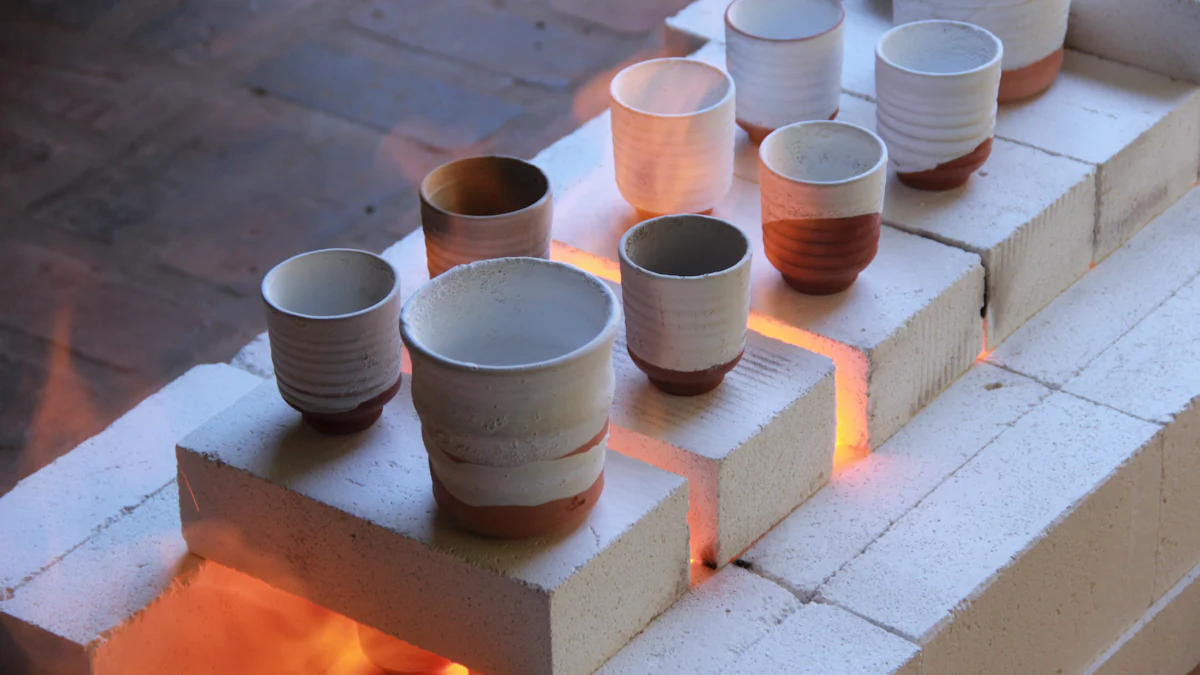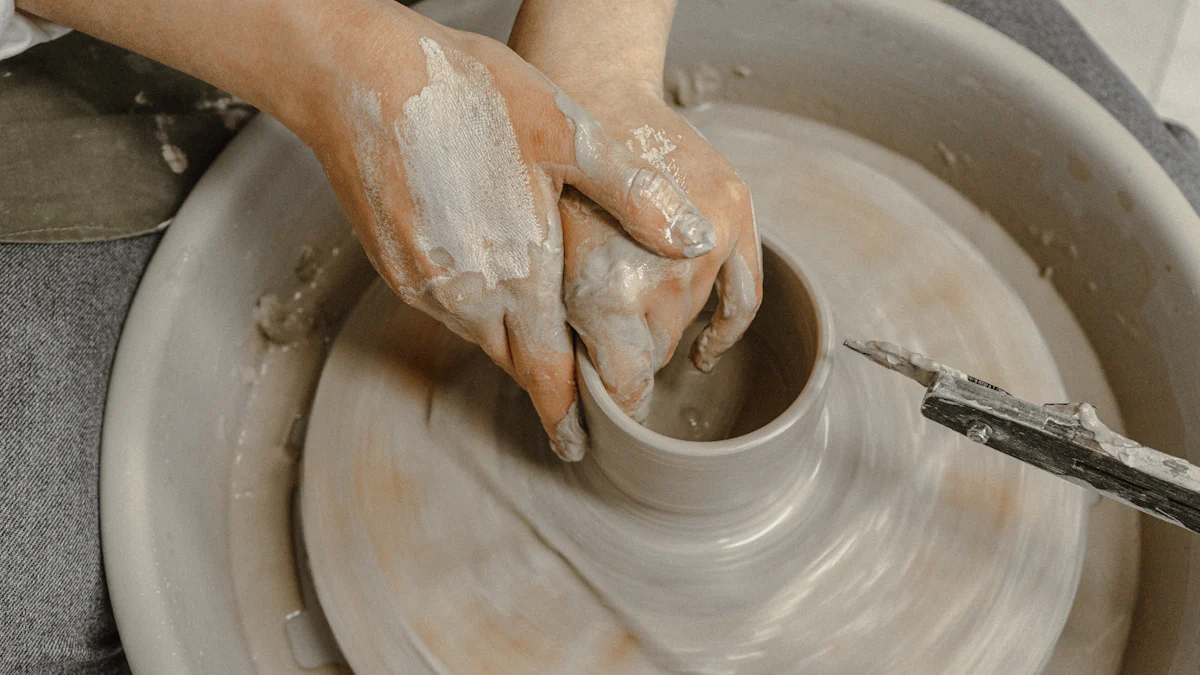Ceramic materials play a pivotal role in modern industries due to their exceptional properties. Their heat resistance and durability make them indispensable in aerospace for turbine blades and heat shields. In healthcare, biocompatible ceramics enhance the longevity of implants. Electronics benefit from their thermal stability, while energy sectors rely on ceramics for fuel cells and solar panels. These materials excel where traditional options fail, offering unmatched performance in extreme conditions. From automotive shock absorbers to biomedical implants, the application of ceramics materials continues to revolutionize technology and improve lives.
Industrial Applications of Ceramic Materials

Electronics and Semiconductors
Ceramic materials have transformed the electronics industry by enhancing the performance and reliability of devices. I’ve observed how ceramic packaging technology improves temperature stability, enabling electronics to function seamlessly in extreme conditions. This advancement reduces power consumption, extending battery life and improving energy efficiency. Additionally, ceramics enhance data transmission rates, which boosts processing speed and responsiveness in modern devices.
Their excellent electrical insulation properties ensure the reliability of electronic components. Heat resistance allows these materials to perform effectively in high-temperature environments. Furthermore, ceramics enable the miniaturization of components without compromising performance, a critical factor in the development of compact and efficient devices. These innovations highlight the vital role of ceramics in the application of ceramics materials within the electronics and semiconductor industries.
Aerospace and Defense
In aerospace and defense, ceramic materials are indispensable due to their unique properties. For instance, alumina provides superior electrical insulation and thermal conductivity, making it ideal for electronic insulators and sensor components. Silicon carbide offers exceptional thermal conductivity and shock resistance, which is crucial for structural components and protective coatings. Silicon nitride excels in high-temperature strength and thermal shock resistance, making it suitable for critical engine parts. Zirconia, with its high fracture toughness, is used in thermal barrier coatings and insulation tiles.
Ceramic coatings further enhance aerospace components by offering heat resistance, corrosion protection, and an optimized weight-to-strength ratio. These coatings withstand temperatures up to 1,800˚F, ensuring durability in extreme conditions. I’ve seen how these properties contribute to the reliability and longevity of aerospace technology.
Automotive Industry
Ceramics play a pivotal role in improving the performance and durability of automotive components. Their lightweight nature, combined with heat, wear, and corrosion resistance, ensures reliability in demanding applications. Advanced ceramics like 96% alumina and yttria-stabilized zirconia maintain their form under mechanical stress while resisting heat and chemicals.
In my experience, ceramics enhance automotive performance in several ways. They are used in engine components, sensors, and braking systems, improving reliability and extending lifespan. Ceramic tire pressure monitoring systems alert drivers to sudden pressure loss, while sensors operate effectively in harsh environments. These materials also contribute to sustainability by reducing energy consumption and extending vehicle lifespans. The application of ceramics materials in the automotive industry continues to drive innovation and efficiency.
Medical and Healthcare Applications of Ceramic Materials

Bioceramics in Implants
Ceramic materials have revolutionized the field of medical implants. I’ve observed how bioceramics, such as hydroxyapatite and zirconia, are widely used in orthopedic and dental implants due to their biocompatibility. These materials integrate seamlessly with human tissues, reducing the risk of rejection or inflammation. Their exceptional strength and wear resistance ensure long-term durability, even under the mechanical stresses of daily activities.
In joint replacements, bioceramics provide smooth surfaces that minimize friction, enhancing mobility and comfort for patients. For example, ceramic-on-ceramic hip implants offer superior wear resistance compared to traditional metal or polymer alternatives. I’ve also seen how bioceramics are used in bone grafts, where their porous structure promotes natural bone growth and regeneration. These advancements highlight the critical role of ceramics in improving patient outcomes and quality of life.
Dental Applications
Ceramics have become indispensable in modern dentistry. I’ve noticed their widespread use in crowns, bridges, veneers, and implants due to their unique advantages over other materials.
- Aesthetics: Ceramics mimic the appearance of natural teeth, boosting patient confidence.
- Biocompatibility: They are well-tolerated by the body, minimizing adverse reactions.
- Strength and Durability: Ceramics withstand significant biting forces, ensuring longevity.
- Natural Bite Alignment: They can be shaped to match a patient’s bite for proper occlusion.
- Tissue Compatibility: Ceramics promote healthy gum integration, reducing inflammation risks.
- Material Versatility: Different ceramics suit various dental needs and implant locations.
- Longevity: They resist wear and staining, providing a lasting solution.
Commonly used ceramics include zirconia, known for its strength and durability, and lithium disilicate, which combines strength with translucency for anterior teeth. I’ve seen how feldspathic ceramics, with their high translucency, are ideal for veneers, while leucite-reinforced ceramics balance aesthetics and strength for crowns. These materials ensure that the application of ceramics materials in dentistry continues to set new standards for patient care.
Environmental and Energy Applications of Ceramic Materials
Renewable Energy
Ceramic materials have become essential in renewable energy technologies. I’ve seen how their unique properties enhance the efficiency and reliability of energy systems. For instance, ceramics are integral to solar panels, where they improve thermal stability and durability. Capacitors and high-temperature supercapacitors also rely on ceramics to store and manage energy effectively.
In fuel cells, ceramics serve as separators and coatings, enabling the conversion of chemical energy into electrical energy with minimal emissions. This clean energy alternative reduces reliance on fossil fuels. Solid-state batteries, which use ceramics as solid electrolytes, offer safer and higher-performance energy storage solutions. Advanced ceramics also play a role in energy distribution and sensor devices, ensuring the smooth operation of renewable energy systems. These applications demonstrate how ceramics contribute to sustainable energy solutions.
Water Filtration
Ceramics have revolutionized water filtration systems by providing an efficient and durable solution for clean water. Their porous structure traps contaminants like bacteria and protozoa, ensuring safe drinking water. I’ve observed how ceramic filters surpass WHO standards, with removal efficiencies of 59.6% for turbidity, 86.3% for total coliform, and 87.6% for E. coli.
The addition of colloidal silver enhances antimicrobial properties, further improving filtration efficiency. Ceramic membranes, with their tiny pores, block bacteria and larger particles while maintaining chemical stability. These filters are easy to clean and reuse, making them ideal for long-term use in areas lacking safe water. Recent advancements have improved fouling resistance, ensuring reliability and longevity. The structural integrity of ceramics ensures they remain strong and effective over time, making them a cornerstone of modern water filtration systems.
Everyday Applications of Ceramic Materials
Household Items
Ceramic materials have been a cornerstone of household items for centuries. I’ve noticed their widespread use in everyday objects like jugs, vases, pots, planters, and kitchenware. Their durability and heat resistance make them ideal for cookware and tableware, while their corrosion resistance ensures longevity. Porcelain, a refined type of ceramic, stands out for its fine quality and versatility. It’s commonly used in dinnerware, decorative items, and even electrical insulators.
Historically, ceramics have evolved significantly. Around 9,000 BCE, people began using clay-based ceramics for food and water storage. The invention of the wheel in 3,500 BCE revolutionized ceramic production, enabling more intricate designs. Over time, ceramics transitioned from purely utilitarian objects to items that blend functionality with aesthetic appeal. Today, they remain indispensable in households worldwide.
However, safety considerations are crucial when using ceramics for food-related purposes. I always recommend opting for lead-free glazes to prevent harmful leaching, especially when acidic foods are involved. Regular testing for toxic metals like cadmium and barium ensures the safety of ceramic foodware.
Artistic and Decorative Uses
Ceramics have long been a favored medium for artistic expression. I’ve seen how artists manipulate shape, volume, and color to create stunning pottery, tiles, and sculptures. These pieces often serve decorative purposes, showcasing the versatility of ceramic art.
Ceramic art holds cultural significance across the globe. Indigenous cultures, such as the Moche and Maya, used pottery to reflect their traditions and beliefs. In ancient Egypt, pottery provided insights into daily life and religious practices. Japanese ceramics, particularly those used in tea ceremonies, exemplify the fusion of artistry and cultural heritage.
The ability to mold ceramics into intricate forms makes them a preferred material for artists. Whether it’s a hand-painted vase or a sculpted figurine, ceramic art continues to captivate with its timeless beauty. This artistic application of ceramics materials highlights their role in preserving cultural identity and inspiring creativity.
Ceramic materials have proven their versatility across industries, from aerospace to healthcare. I’ve seen how they enhance technological advancements by improving temperature stability, reducing power consumption, and increasing data transmission rates. Their role in medical devices and renewable energy systems demonstrates their impact on healthcare and environmental sustainability.
Emerging innovations, like advanced ceramic composites and additive manufacturing, promise even greater potential. These breakthroughs enable smaller, faster, and more efficient devices while supporting precision engineering for complex geometries. The application of ceramics materials continues to shape the future, driving progress in technology and sustainability.
FAQ
What makes ceramic materials unique compared to metals or polymers?
Ceramics offer superior heat resistance, electrical insulation, and durability. I’ve noticed they outperform metals and polymers in extreme conditions, making them ideal for specialized applications.
How are ceramics used in renewable energy systems?
Ceramics enhance solar panels, fuel cells, and solid-state batteries. Their thermal stability and chemical resistance improve efficiency and reliability in renewable energy technologies.
Are ceramic materials environmentally friendly?
Yes, ceramics contribute to sustainability. I’ve seen their role in clean energy, water filtration, and long-lasting products, reducing waste and environmental impact.
